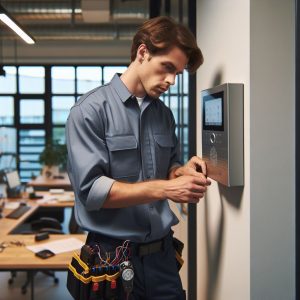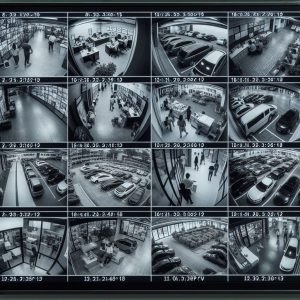HIntroduction
Home security technology has evolved significantly in recent years, expanding far beyond basic locks and alarms to include sophisticated, tech-driven solutions that enhance protection and convenience. From smart cameras with AI capabilities to fully integrated smart home security systems, new trends are reshaping how homeowners protect their properties. Staying informed on the latest home security innovations can help you select the right solutions for your home and stay one step ahead of potential intruders.
In this article, we’ll explore the key trends in home security technology and discuss how each can contribute to improved safety and peace of mind for you and your family.
1. Smart Cameras with AI Detection and Facial Recognition
One of the most exciting advancements in home security technology is the integration of artificial intelligence (AI) in smart home security cameras. These smart cameras now feature capabilities like facial recognition, motion detection, and even pet detection, allowing them to distinguish between familiar faces, visitors, and unknown individuals. AI-enabled cameras can reduce false alerts, making notifications more accurate and effective.
Benefits:
- Smart cameras with AI detection reduce unnecessary alerts by recognizing familiar faces.
- Facial recognition helps identify regular visitors and sends alerts when unknown individuals are detected, making your home surveillance system more efficient.
2. Cloud Storage and Remote Access for Real-Time Monitoring
Cloud storage has become a standard feature of modern home security systems, allowing users to securely store video footage and access it remotely. With remote home monitoring through mobile apps, you can check in on your home from anywhere in the world. Many systems also offer backup storage to prevent loss of footage during internet outages.
Benefits:
- Remote access lets you monitor your property on the go, offering peace of mind.
- Cloud storage provides an added layer of security by ensuring that important video footage is safely stored off-site.
3. Smart Locks and Keyless Entry Systems
Smart locks and keyless entry systems are quickly replacing traditional door locks, combining convenience with enhanced security. These smart locks can be controlled via smartphone, eliminating the need for physical keys and allowing you to lock or unlock doors remotely. Many systems offer temporary codes, providing temporary access for guests or service providers.
Benefits:
- Enhanced control over who enters your home with real-time alerts when someone accesses the lock.
- Smart locks and keyless entry reduce the risk of lost keys while enabling remote door access from your mobile device.
4. Integration with Full Smart Home Systems
Home security systems are increasingly integrating with other smart home devices, creating a cohesive, fully connected home environment. Systems compatible with virtual assistants like Alexa or Google Assistant allow users to control security through voice commands or to automate various security tasks, enhancing convenience and usability.
Benefits:
- Seamless control over multiple security devices from one platform, enhancing convenience and efficiency.
- The ability to schedule tasks, receive alerts, and monitor your entire security setup through a smartphone or virtual assistant.
5. Advanced Motion Detection Technology
Motion detection technology has advanced significantly, now offering greater accuracy and fewer false alarms. Newer motion detectors use both infrared and microwave sensors to differentiate between harmless movements, such as pets, and actual threats. Dual-sensor technology helps to reduce false alarms, ensuring alerts only when necessary.
Benefits:
- Advanced motion detection minimizes false alarms for more reliable security.
- Customizable sensitivity settings allow for fine-tuning of security based on specific needs and areas.
6. Biometric Security Solutions
Biometric security is now more accessible, bringing advanced identification technology into home security. Options such as fingerprint door locks, voice recognition, and even retina scanners provide an extra layer of protection and eliminate the need for physical keys, making home access both secure and convenient.
Benefits:
- Enhanced security with biometric access control that is difficult to duplicate or bypass.
- Keyless, personalized entry that adds convenience and reduces the risk of unauthorized access.
7. Environmental and Safety Sensors
Modern home security systems increasingly include environmental sensors that detect hazards like smoke, carbon monoxide, and water leaks. These home safety sensors extend protection beyond intrusions, safeguarding against potentially harmful environmental risks. Integrated safety sensors offer real-time alerts for immediate action, helping to prevent accidents or mitigate damage.
Benefits:
- Environmental sensors add protection against hazards such as fires and leaks.
- Quick alerts help homeowners act fast to minimize damage from environmental risks.
8. Drones for Home Surveillance
Drones are emerging as a novel tool for home surveillance, particularly for larger properties. Equipped with cameras, drones can patrol perimeters, detect unusual activity, and provide a bird’s-eye view of the area. Some security companies are exploring drone integration for home and property security, enhancing surveillance capabilities for larger estates or hard-to-reach areas.
Benefits:
- Drones offer enhanced surveillance capabilities for large properties.
- Aerial surveillance with drones can cover areas that traditional cameras may not reach, providing comprehensive property monitoring.
9. Voice-Activated Panic Buttons
Voice-activated panic buttons provide an extra layer of security by allowing users to call for help through specific voice commands. These devices immediately alert emergency contacts or dispatch authorities without needing to physically reach a device. Voice-activated panic alerts are particularly valuable for elderly individuals or those with limited mobility.
Benefits:
- Voice-activated security offers immediate access to help in emergencies.
- Hands-free activation enhances accessibility, making it ideal for seniors or individuals with mobility concerns.
10. Wearable Security Devices
Wearable security devices are growing in popularity, adding a layer of personal safety. Smartwatches and personal alarms, for example, allow users to discreetly alert authorities or family members in emergencies. With GPS tracking capabilities, these devices are especially useful for families with children or elderly individuals, offering real-time location monitoring.
Benefits:
- Wearable security devices provide personal safety that’s always within reach.
- GPS tracking allows real-time monitoring, enhancing family safety and peace of mind.
Final Thoughts
The latest trends in home security technology highlight impressive advancements aimed at enhancing home and personal safety. From smart cameras and AI-driven facial recognition systems to fully integrated smart home security setups, today’s options for safeguarding your property and loved ones are extensive. Embracing these innovations can help you create a secure, efficient, and user-friendly home environment tailored to your needs.
Staying updated on these home security trends not only strengthens your defenses but also provides added convenience, accessibility, and control over your home’s safety. As security technology continues to evolve, investing in these cutting-edge solutions can offer lasting peace of mind for you and your family.





